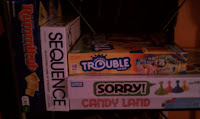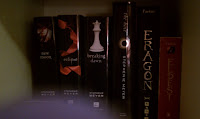Thursday, October 21, 2010
Form + Content: Graphic Design for the 21st Century: Peter Anderson in "UltraVision"
- Graphic Design for the 21st Century
- The original piece was made as a poster design to show that language and type shouldn't fall in straight lines, but in an organic system.
- When you look at this piece, you are interested. You want to know how to figure it. So you read it, or try to, and flow around the entire poster. The idea allows you to look away from the grid but to understand that the piece is meant to show the variability of type and language.
- The shape is almost like an amoeba, and I think: wow what a crazy way to show an amoeba made from type! An amoeba is free flowing, it has not definite shape. This makes you look at EVERYTHING, simply because of curiosity and the fact that there is so much to take in.
- This designer thought about the curiosity of their readers. He wanted you to not be able to see the grid, but to see how organic and fun you can make something. He wanted to keep you interested, and used different colors, fonts, and sizes to make the piece an always changing image.
- The type MAKES the image. It makes the viewers see every letter and every word and see those words in the form of the shape.
Friday, October 8, 2010
Form + Content: Kohkoku Magazine
- Mag-Art: Innovation in Magazine Design
- Shown as a spread of examples of a specific magazine's cover.
- Overall, the issue in questions was trying to convey the idea of what "good design" really is. Through not just the cover, but spreads within the magazine, they were able to show what good design LOOKS like, but also what bad design looks like as well.
- It's really interesting looking at the cover they show. The hands holding a piece of paper and pencil and passing it to another person. It makes you think: this is going to tell me how to design something. I want to know what. So I want to pick up this magazine and find out. The next page shows the concept of the content in the magazine. They want to show you what good design is. The man in the image is all happy and presenting a book, or a package; emphasizing: hey, this is important, this is what it looks like and should be. In the final page, you can see where they begin to show you what it looks like. In the phrase it says "the concern is in style, not content"; it makes the reader understand that the design is not about what point the design gets across, but the actual core image or layout itself.
- They really kept the viewers attention, even in a spread form published in another book, by keeping a changing pattern. No two images in the spread were the same. Use of creativity allows the readers to make an assumption of an image and intrique themselves.
- The type was subtle in both the first and second pages shown, and was highly dominant in the last page. It allowed the first two to be more about "lets design according to your imagination", rather than "this is a guide to accurate design techniques." It allowed the reader to understand what the image is supposed to make you see, without spelling it out for you completely.
Subscribe to:
Comments (Atom)

















